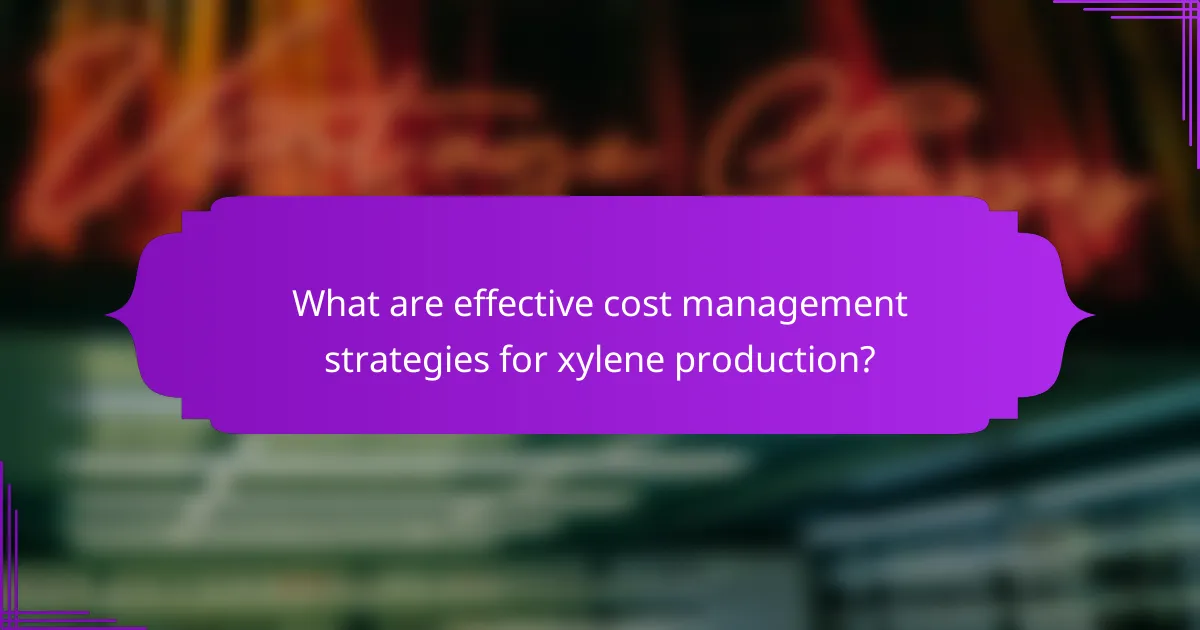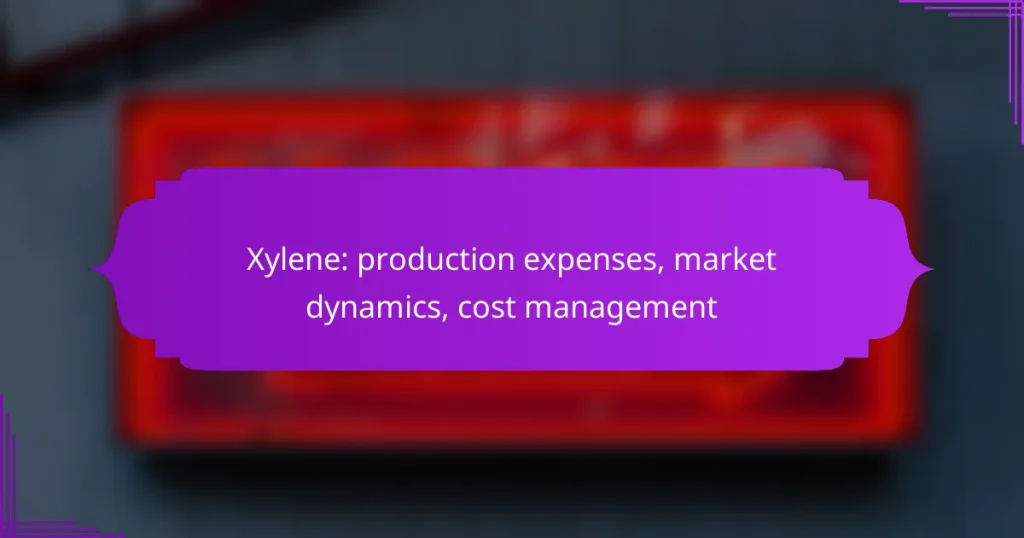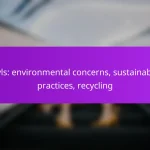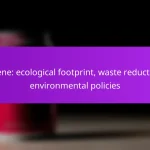Xylene production in New Zealand involves various expenses, including raw materials, labor, and energy, making a thorough understanding of these costs essential for effective management and pricing strategies. Market dynamics, influenced by supply and demand fluctuations, global trends, and crude oil prices, further complicate the pricing landscape. To navigate this competitive environment, stakeholders must adopt cost management strategies that optimize processes and enhance profitability.

What are the production expenses of xylene in New Zealand?
The production expenses of xylene in New Zealand encompass various factors including raw materials, labor, energy, transportation, and regulatory compliance. Understanding these costs is crucial for effective cost management and pricing strategies in the xylene market.
Raw material costs
Raw material costs are a significant component of xylene production expenses. Xylene is derived from crude oil and natural gas, which are subject to price fluctuations based on global market dynamics. In New Zealand, these costs can vary, but they typically represent a substantial portion of the overall production budget.
Producers should monitor the prices of feedstocks and consider long-term contracts to mitigate risks associated with volatile raw material costs. Additionally, sourcing locally can sometimes reduce expenses related to import tariffs and transportation.
Labor expenses
Labor expenses for xylene production include wages, benefits, and training costs for employees. In New Zealand, the average wage for chemical plant workers can vary, but it generally aligns with national labor standards and industry norms. Efficient workforce management can help control these costs.
Investing in employee training and development can enhance productivity and reduce turnover, ultimately leading to lower labor expenses over time. Companies should also evaluate automation options to streamline processes and minimize labor costs.
Energy consumption
Energy consumption is another critical factor affecting xylene production costs. The production process is energy-intensive, relying on electricity and thermal energy. In New Zealand, energy prices can fluctuate based on supply and demand, impacting overall production expenses.
Producers can explore renewable energy options or energy-efficient technologies to reduce costs. Implementing energy management systems can help monitor usage and identify areas for improvement, leading to significant savings.
Transportation costs
Transportation costs involve the logistics of moving raw materials to production sites and distributing finished xylene products to customers. In New Zealand, these costs can be influenced by geographic factors and the choice of transportation methods.
To optimize transportation expenses, companies should evaluate their supply chain logistics and consider consolidating shipments. Partnering with reliable logistics providers can also enhance efficiency and reduce costs.
Regulatory compliance costs
Regulatory compliance costs are associated with adhering to environmental and safety regulations in xylene production. In New Zealand, companies must comply with local and national regulations, which can involve fees for permits, inspections, and reporting.
Staying informed about regulatory changes and investing in compliance training can help minimize potential fines and disruptions. Companies should also consider implementing best practices to enhance safety and reduce environmental impact, which can lead to long-term cost savings.

How do market dynamics affect xylene pricing?
Market dynamics significantly influence xylene pricing through variations in supply and demand, global trends, crude oil prices, and trade policies. Understanding these factors is essential for stakeholders in the xylene market to manage costs effectively and anticipate price changes.
Supply and demand fluctuations
Supply and demand fluctuations are critical in determining xylene prices. When demand for xylene increases, perhaps due to a rise in the production of plastics or solvents, prices tend to rise as suppliers may struggle to keep up. Conversely, if there is an oversupply, prices can drop significantly, impacting profitability for producers.
Producers should monitor industry trends and adjust production levels accordingly to avoid excess inventory or shortages. Engaging in market analysis can help anticipate shifts in demand, allowing for better planning and cost management.
Global market trends
Global market trends play a vital role in xylene pricing, as they can affect both supply chains and consumer demand. For instance, economic growth in emerging markets often leads to increased demand for petrochemicals, including xylene, which can drive prices up. Conversely, economic downturns can lead to decreased demand and lower prices.
Staying informed about global economic indicators, such as GDP growth rates and industrial production statistics, can help stakeholders make informed decisions regarding pricing and inventory management.
Impact of crude oil prices
Crude oil prices have a direct impact on xylene pricing since xylene is derived from petroleum. When crude oil prices rise, the cost of producing xylene typically increases, leading to higher market prices. Conversely, a drop in crude oil prices can result in lower xylene prices.
Producers should monitor crude oil price trends and consider hedging strategies to mitigate the impact of price volatility on xylene production costs. Understanding the correlation between crude oil and xylene prices can aid in strategic financial planning.
Trade policies and tariffs
Trade policies and tariffs can significantly affect xylene pricing by altering import and export costs. Tariffs on imported xylene can lead to higher prices domestically, while favorable trade agreements may reduce costs and increase competition in the market.
Stakeholders should stay updated on trade regulations and potential tariff changes that could impact their operations. Engaging with trade associations and industry groups can provide insights into upcoming policy changes and help businesses adapt their strategies accordingly.

What are effective cost management strategies for xylene production?
Effective cost management strategies for xylene production focus on optimizing processes, negotiating with suppliers, improving energy efficiency, and reducing waste. Implementing these strategies can lead to significant cost savings and enhanced profitability in the competitive xylene market.
Process optimization techniques
Process optimization involves refining production methods to enhance efficiency and reduce costs. Techniques such as continuous monitoring of production parameters and implementing advanced control systems can help identify bottlenecks and streamline operations.
Adopting lean manufacturing principles can also minimize waste and improve workflow. For example, using just-in-time inventory systems can reduce holding costs and ensure that materials are available when needed, without excess stock.
Supplier negotiation tactics
Effective supplier negotiation can significantly impact xylene production costs. Establishing long-term relationships with suppliers can lead to better pricing and terms. Regularly reviewing contracts and seeking competitive bids can also help ensure favorable conditions.
Consider consolidating purchases with fewer suppliers to increase bargaining power. Additionally, leveraging market intelligence to understand pricing trends can provide a strategic advantage during negotiations.
Energy efficiency improvements
Improving energy efficiency is crucial for reducing operational costs in xylene production. Implementing energy-efficient technologies, such as high-efficiency boilers and heat exchangers, can lead to substantial savings on energy bills.
Regular energy audits can identify areas for improvement. Simple measures, like optimizing equipment usage and scheduling maintenance, can enhance overall energy performance and reduce wasteful consumption.
Waste reduction practices
Reducing waste in xylene production not only lowers disposal costs but also enhances sustainability. Implementing a waste management program that includes recycling and reusing materials can minimize the environmental impact and improve cost efficiency.
Training employees on waste reduction techniques and encouraging a culture of sustainability can lead to innovative solutions. For instance, capturing and reusing solvents can significantly decrease raw material costs and waste generation.

What are the key factors influencing xylene demand in New Zealand?
The demand for xylene in New Zealand is primarily influenced by its industrial applications and evolving consumer trends. Factors such as production capacity, economic conditions, and regulatory frameworks also play significant roles in shaping market dynamics.
Industrial applications
Xylene is extensively used in various industrial applications, including the production of solvents, paints, and coatings. Its role as a chemical intermediate in the manufacturing of plastics and synthetic fibers further drives demand. Industries such as automotive and construction rely heavily on xylene for its properties, which enhance product performance.
In New Zealand, the demand for xylene is closely tied to the growth of these sectors. Fluctuations in construction activity or automotive production can significantly impact xylene consumption. Companies should monitor these industries to anticipate changes in xylene demand and adjust their procurement strategies accordingly.
Consumer trends
Consumer preferences are shifting towards more sustainable and eco-friendly products, which can affect xylene demand. As industries seek to reduce their environmental footprint, alternatives to xylene may gain traction, influencing market dynamics. However, xylene’s unique properties still make it a preferred choice in many applications.
In New Zealand, awareness of environmental issues is growing, prompting companies to explore greener alternatives. Businesses should stay informed about consumer trends and regulatory changes to adapt their product offerings and maintain competitiveness in the market.


